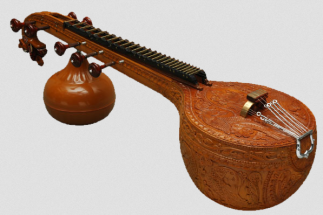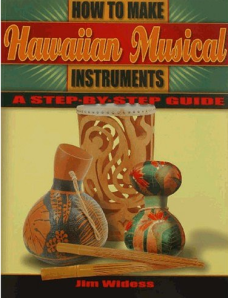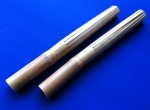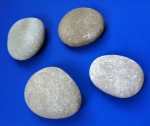 Although it may look a bit like a sitar, the Indian veena (or vina) is a unique instrument that dates back at least to 1,500 BCE and has its own distinctive place in Hindustani as well as the Carnatic style South Indian music. A person who plays the veena is known as a vainika.
Although it may look a bit like a sitar, the Indian veena (or vina) is a unique instrument that dates back at least to 1,500 BCE and has its own distinctive place in Hindustani as well as the Carnatic style South Indian music. A person who plays the veena is known as a vainika.
Mentioned throughout ancient texts such as Bhagavata, the veena is often seen being held by Saraswati, the Hindu patron Goddess of learning and the arts. The Goddess is usually depicted seated on a swan and playing the instrument. In addition to Saraswati, Lord Shiva is also depicted as playing or holding a veena in a form known as a Vinadhara,” meaning “bearer of the vina.”

The modern veena (seen above) has quite a few variations as it evolved throughout various regions and playing styles. Generally, a modern veena is a beautifully constructed plucked stringed instrument that is about four feet in length. It has 7 strings, can be fretted or fretless and has a gourd-like resonator, like the sitar. The vainika plays while seated cross-legged and the instrument is tilted slightly away from the player. The veena can be used to play both classical Indian music or contemporary musical songs or themes.
In addition to the modern veena, there is also an ancient veena which is related to the Burmese harp. Arched harps; like the ancient veena, appeared in the artwork of ancient Egypt and India and were also found widely throughout Southeastern Asia and East Africa.
Links and Resources
SRUTI India Music and Dance Society (Philadelphia, PA USA)
Dhvani – India Performing Arts Society of Central Ohio (USA)
https://www.dhvaniohio.org/music/music-south-india/
Instruments of India – Kids Mini-Course
https://www.teacherspayteachers.com/Product/Instruments-of-India-Mini-Course-2682389
Sitar Poster And Coloring Page
https://www.teacherspayteachers.com/Product/Instruments-From-India-The-Sitar-904627



























 The beautiful, wide and diverse continent of Africa has some truly amazing and clever musical creations. One of my favorites is a small percussion instrument called a tongue rattle. Generally made from carved wood, the rattle is shaken quickly back and forth and a “tongue” within the two carved sides makes a noise like a person who just can’t stop talking.
The beautiful, wide and diverse continent of Africa has some truly amazing and clever musical creations. One of my favorites is a small percussion instrument called a tongue rattle. Generally made from carved wood, the rattle is shaken quickly back and forth and a “tongue” within the two carved sides makes a noise like a person who just can’t stop talking.
 of the cup. Here’s a picture of what that might look like.
of the cup. Here’s a picture of what that might look like. Play Your Tongue Rattle
Play Your Tongue Rattle Win a Carved African Tongue Rattle
Win a Carved African Tongue Rattle